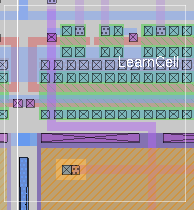



Mouse buttons 1 and 3 pressed in the GUI window toolbar implement the see and see no commands for the layer represented by the toolbar button.
see [no] layers|allSame
where layers is a comma-separated list of layers in the technology, and may also be the character * indicating all layers but not labels, $ indicating all layers under the cursor not including labels and subcells, labels indicating only labels, error indicating DRC error paint, subcell indicating subcells, and connect indicating all types connected to the type or types preceding it.
The see command allows various layers in the layout to be made visible, including labels and error paint. With the keyword no, the command causes these layers to be made invisible on the display.The keyword allSame is a special use and indicates that non-edit cells should be drawn in the same manner as the edit cell, rather than being drawn in the "pale" styles.
The keyword connect is only meaningful when it comes after one or more listed types. It will expand the list of types to include types electrically connected to those types.
The special keyword $ is only meaningful when used with option "see no", as it refers to all layers visible directly under the pointer cursor, and it is not possible to query invisible layers.
Starting with Magic version 7.5, contacts whose residue layers (layers surrounding the cut) are partially visible and partially invisible will show the visible residue when the contact type itself is invisible. That way, the command "see no * ; see m1", for example, will show all metal1 including that under contacts, preventing the display of gaps in the metal1 layer where contacts are present. Note that this applies only to contacts, where the residue layers are declared in the techfile and therefore known a priori. Other layers, such as metal1 resistor (often appears as "rmetal1" in techfiles), have no relation to metal1 that can be definitively determined from the techfile. Therefore, to see all layers corresponding to a single production mask layer, it is necessary to explicitly call out all such layers int the layers list.
Undisplayed layers generally do not respond to commands such as erase or select. However, network selection will select across invisible layers, and copying or moving such a network selection will alter the invisible layers as well as the visible.
see is implemented as a built-in command in magic.
It should be enforced everywhere in the code that invisible layers cannot be altered. This may require removing invisible layers from a selection after doing a network connectivity search.

| Return to command index |
Last updated: March 7, 2020 at 1:06pm